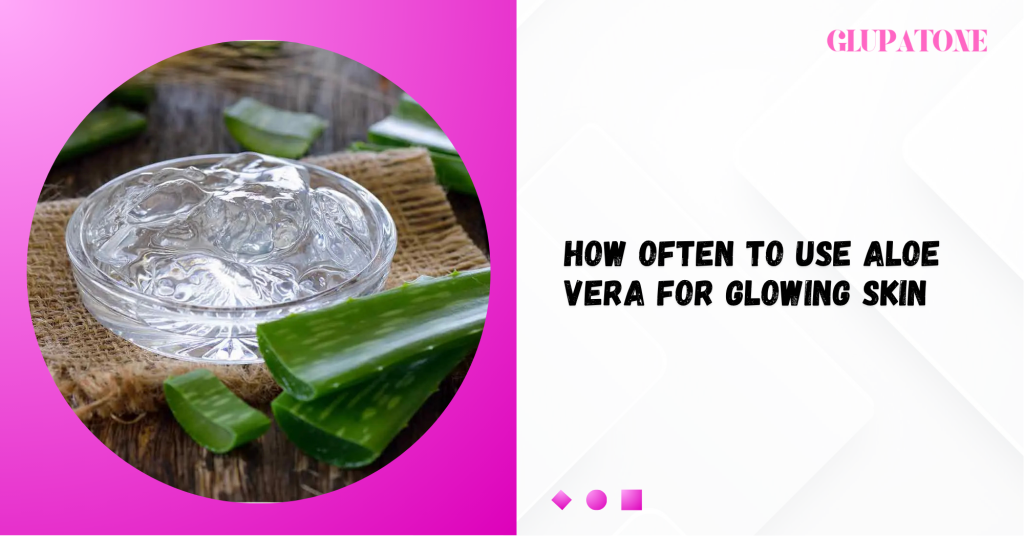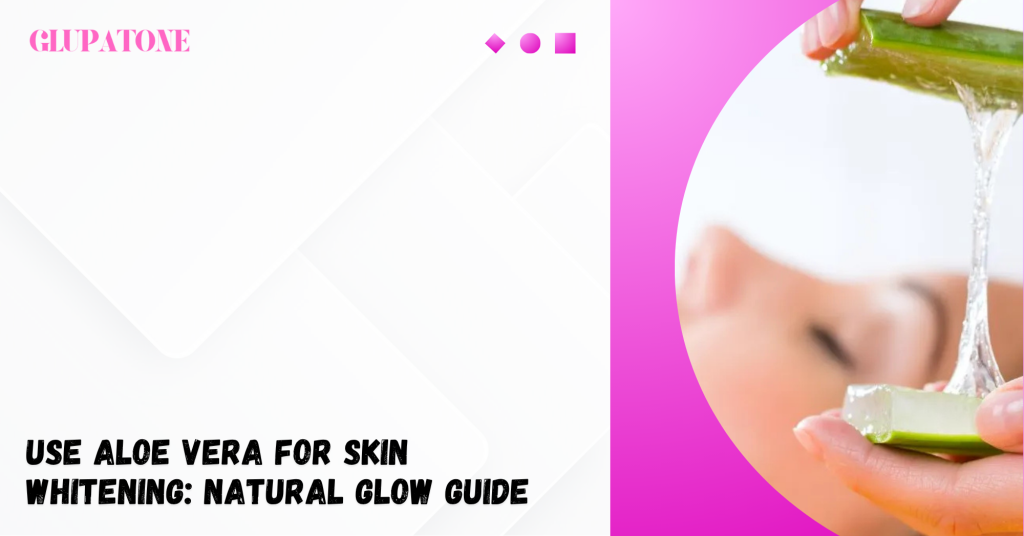Introduction to Aloe Vera in Skincare
Aloe vera is that magical green plant we all know and love! Inside its thick leaves is a clear gel that’s packed with nutrients, enzymes, and soothing properties. It’s been used for centuries to treat everything from sunburns to dry skin — and now, it’s a rising star in natural skin whitening too!
Why Aloe Vera Is Loved for Skin Brightening
People adore aloe vera because it’s gentle, soothing, and works beautifully on all skin types. It’s not just hydrating. Use Aloe Vera for Skin Whitening, it helps fade marks, calm inflammation, and bring out that natural glow. And the best part? It’s all-natural! That’s why it’s often paired with skin care products like Glupatone, which boosts and maintains those brightening effects over time.
How Aloe Vera Helps with Skin Whitening
Natural Compounds That Brighten Skin
Aloe vera is rich in aloin and aloesin, two natural compounds that help reduce pigmentation and support a more even skin tone. These work like little helpers that gently slow down melanin production — and that’s exactly what gives your skin a brighter, healthier look.
Reducing Pigmentation, Acne Scars, and Dullness
If you’re dealing with dark spots, acne marks, or dull, uneven skin — aloe vera might just become your go-to! It doesn’t bleach your skin but instead helps heal it from within. For an even better effect, pair your aloe vera routine with Glupatone Emulsion, which is formulated to enhance clarity, target stubborn spots, and maintain your results long-term.
Illuminate Your Beauty—Start Your Skin Brightening Journey with Glupatone.
Target Hyperpigmentation at Its Core—Glupatone Does the Work While You Glow!
Aloe Vera vs. Glupatone: Which One Is Better?
Let’s be honest — both have their perks! Aloe vera is a natural gem, but if you want faster, targeted results, Glupatone offers a dermatologist-backed formula with powerful brightening ingredients like Glutathione, Kojic Acid, and Vitamin C. So, it’s not really either/or — it’s about balance.
How Glupatone Complements Aloe Vera for Even-Toned Skin
Aloe vera soothes and prepares the skin, making it more receptive to other products. That’s why many users apply aloe vera before or after using Glupatone Emulsion to calm the skin and enhance its glow. This combo can be especially great for sensitive skin types — but remember, always patch test first!
Best Ways to Use Aloe Vera for Skin Brightening
Using Fresh Aloe Vera Gel
Fresh is fabulous! Simply cut an aloe leaf, scoop out the clear gel, and apply it directly to your skin. Let it sit for 15–20 minutes before rinsing. It feels refreshing and gives your skin a dewy finish. You can also chill the gel in the fridge for an extra soothing effect.
Store-Bought Aloe Vera: What to Look For
If fresh aloe isn’t an option, no worries! When buying aloe vera gel from the store, look for one that’s pure, fragrance-free, and dye-free. Choose products with a high aloe percentage — ideally 90% or more. And again, if you’re using Glupatone products alongside, apply aloe gel first, let it absorb, and then go in with your emulsion or cream.
DIY Aloe Vera Face Masks for Skin Whitening
Aloe Vera and Lemon Juice
This is a classic! Mix one tablespoon of fresh aloe vera gel with a few drops of lemon juice. Lemon helps fade dark spots while aloe keeps the skin calm and moisturized. Use this combo only a few times a week — lemon can be strong, so go gentle if you have sensitive skin.
Aloe Vera and Turmeric Combo
Turmeric is amazing for clearing up dullness and evening out skin tone. Add a pinch of turmeric to a spoonful of aloe vera gel. Apply it evenly and rinse after 15 minutes. It’s perfect for brightening and calming the skin — especially if you’ve had a long, sunny day.
Aloe Vera with Honey and Yogurt
For extra nourishment, mix aloe vera with honey and plain yogurt. This face mask feels super refreshing and works to smooth out your skin while adding a healthy glow. It’s ideal for dry or tired-looking skin!
Aloe Vera and Rose Water for Sensitive Skin
Need something extra gentle? Mix aloe gel with rose water. It cools, hydrates, and helps calm redness or irritation. You can even use this daily like a light mask or toner before applying your Glupatone Emulsion.
How to Apply Aloe Vera on the Face
Start with clean, dry skin. Gently apply the aloe mask using your fingertips or a brush. Make sure you cover your face evenly, but avoid the eyes and lips. Let it sit for 15–20 minutes — then rinse with lukewarm water.
How Long to Leave It On and Rinse Tips
Leave the mask on just until it begins to dry — don’t wait until it’s flaky! Rinse it off gently using circular motions, then pat your face dry with a soft towel. Follow up with a moisturizer or your Glupatone Emulsion if you use it.

How Often to Use Aloe Vera for Glowing Skin
Daily vs. Weekly Usage
For fresh glow daily, plain aloe vera gel can be used every day. But if you’re using stronger combos like lemon or turmeric, stick to 2–3 times a week. It’s all about what your skin can handle.
Best Time to Apply (Morning vs. Night)
You can use aloe masks any time, but nighttime is perfect — your skin has time to relax and repair. If you’re pairing with Glupatone, use aloe in the morning and Glupatone at night or alternate days for best results.
Combining Aloe Vera with Glupatone Emulsion
Should You Mix or Alternate?
It’s not necessary to mix them together. Instead, alternate their use — aloe vera during the day for soothing, and Glupatone at night for deep brightening effects. This combo lets both work their magic without overloading your skin.
Who Benefits Most from This Routine
This routine is great for anyone dealing with dullness, sunspots, or tired-looking skin. It’s especially helpful for normal to oily skin types. But remember, everyone’s skin is different — always patch test and listen to your skin.
Safety Tips When Using Both
Avoid using aloe vera right after strong exfoliants or scrubs. If you’re applying both aloe and Glupatone in one day, give a few hours gap between them.
And of course, talk to a skincare advisor or dermatologist before starting a new routine, especially if you have sensitive or reactive skin.
Safety Tips for Using Aloe Vera on Skin
Patch Testing for Sensitive Skin
Before applying aloe vera to your face, always do a patch test. Dab a little gel on your inner arm and wait 24 hours. If there’s no irritation, it’s likely safe to use. This is especially important if you plan to combine aloe with Glupatone Emulsion or any other skin product.
💡 Note: Even natural ingredients can trigger allergies. Always consult a skincare advisor if you’re unsure.
When to Avoid Aloe Vera Use
Avoid aloe vera masks if you’ve just exfoliated or used active ingredients like AHA/BHA. Also, skip it if you notice redness or itchiness after application. If your skin is sunburned or cracked, consult a dermatologist before using any treatment.
Expected Results and Skin Changes
How Long It Takes to See Visible Brightening
With consistent use 2–3 times a week, you may begin to notice a soft glow and brighter complexion within 2 to 4 weeks. Pairing aloe treatments with a reliable skin brightener like Glupatone can speed up visible results.
Signs It’s Working for You
If your skin looks smoother, feels hydrated, and starts to even out in tone, that’s a good sign aloe vera is working. Diminished dullness and improved texture are other positive effects.
Reveal a Brighter, More Radiant You—Experience Glupatone Today!
Glow Naturally! Achieve Even Skin Tone with the Power of Glupatone.
Conclusion: Can Aloe Vera Really Whiten Skin Naturally?
Aloe vera can help with gentle brightening and evening out skin tone over time. It’s not a magic fix — but it’s a natural helper. When paired with Glupatone products, it becomes part of a more powerful routine that blends nature with dermatologically supported skincare.
Remember: no product is one-size-fits-all. Always consult a dermatologist or skincare advisor before starting a new treatment, especially if you have ongoing skin concerns.
Frequently Asked Questions (FAQs)
Can I use aloe vera on my face daily?
Yes, pure aloe vera gel is gentle enough for daily use, especially if your skin isn’t too sensitive.
Does aloe vera permanently lighten skin?
No, it offers temporary brightening and improved clarity over time. For deeper results, consider pairing it with a product like Glupatone Emulsion.
Can aloe vera be mixed with Glupatone cream?
It’s better to use them separately. Apply aloe vera in the morning and Glupatone at night, or alternate daily. Always do a patch test before using both.
What’s the best time to apply aloe vera gel?
Nighttime is ideal, as your skin rests and absorbs nutrients better. But it can also be used in the morning as a soothing base.
Is aloe vera safe for acne-prone or sensitive skin?
Usually, yes — but test first. If you’re already using treatments like salicylic acid or benzoyl peroxide, check with a skin expert before combining.
Should I moisturize after aloe vera use?
Yes. Once aloe dries, follow with a light moisturizer or your Glupatone Emulsion to lock in hydration and enhance results.
Can men use aloe vera for skin whitening?
Absolutely! Skin care is for everyone, and aloe vera works well for all genders.
Does aloe vera help remove dark spots?
It may gradually reduce dark spots due to its anti-inflammatory and regenerative properties. Pairing with Glupatone enhances this effect.
Read More:

